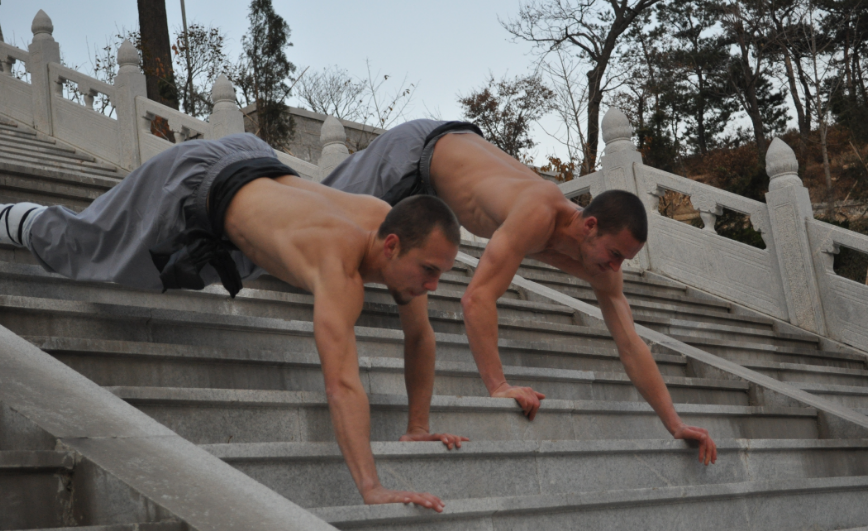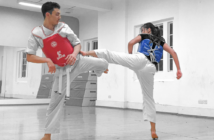The infamous Shaolin mountain run is fundamental part of Shaolin Kung Fu training. Whether you’re studying at one of the many kung fu schools in and around the Songshan Shaolin Temple or somewhere else, the run normally begins each morning before breakfast, or at minimum takes place once a week. This type of mid-distance hill climb not only pushes the body but the will power of students as they charge up and down the mountain, often descending steep steps on all fours. This type of traditional training places emphasis on strength and stamina. It separates the weak from the chaff.
In order to properly prepare yourself before you arrive in China as well as improve your strength, stamina and potential running times I’ve put together these three core running workouts that you can do throughout the week.
 1. Aerobic Workouts and Preparation:
1. Aerobic Workouts and Preparation:
The mountain run is all about running at a consistent and comfortable speed with the right cadence to reduce effort and build fat-burning exnzymes, cardiovascular endurance, and time on your feet. Alternating between long runs and short sprint training is a good tactic as a training method. As is making sure you start your hill climb in the knowledge that a power hike on the upward climb might be more efficient than running until you’ve built up your endurance and stamina. Power hiking is something that can also be trained for and is an excellent way to keep your heart rate in check. Another highly recommended tip is to swap your kung fu shoes for running shoes. Kung Fu shoes are super cool and excellent for form practice, but for the sake of injury prevention do the mountain run in your running shoes. You’ll thank me later.
2. Threshold Workouts:
The threshold is where your body begins to use more glycogen for energy and less fat, and when you train at and slightly above it, you can “raise the roof,” so to speak, so you can run faster at easier efforts (pretty cool). There are several workouts that you can fit in this slot, below are three.
How to find “threshold effort”: You know you’re at this effort when things start to feel uncomfortable, and it’s hard to talk. If you can get out one word responses, you’re there. If you can tell me what you did last night, you need to pick things up. If you’re gasping for air, slow it down. Because this is a physiologically based run, it works best when running by your effort rather than a pace; as you gain fitness, your pace will improve or you may slow down when the elements are challenging (heat and humidity). At the kung fu school its relatively easy to bond with other students. Finding a running partner is not going to be difficult. Doing the mountain run together and talking to each other supporting and driving each other you are able to find your threshold effort. With your partner you can select a combination of the three workouts or choose the most appropriate one that fits with your training schedule.
Five-Minute Tempo Workout:
Warm up three minutes walking. Run 10 minutes at an easy effort (conversational).
Repeat four to five times: Run five minutes at or slightly above your threshold. Recover by jogging easy for two minutes in between. Cool down running five minutes easy and walking three minutes slowly.
2 or 3 x 10-Minute Tempo Workout:
Warm up three minutes walking. Run 10 minutes at an easy effort (conversational).
Repeat two to three times: Run 10 minutes at or slightly above your threshold effort. Recover by jogging easy for two minutes in between. Start with two repeats and build to three over time (maybe even next season). Cool down running five minutes easy and walking three minutes slowly.
20-30 Minute Tempo Workout:
Warm up three minutes walking. Run 10 minutes at an easy effort (conversational).
Run 20-30 minutes at or slightly above your threshold effort. Cool down running 10 minutes at an easy effort and walking 3 minutes slowly.
3. HIIT (High Intensity Interval Workouts):
These workouts may be the hardest effort-wise, but they also make the most dramatic changes in aerobic fitness, speed, metabolism and caloric burn, and overall fitness. My favourite HIIT Workout is:
1-2-3 Intervals:
Warm up three minutes walking. Run 10 minutes at an easy effort (conversational).
Repeats two to three times: Run one minute at a hard but controlled effort in the red zone. Recover with one minute easy walk or jog. Run two minutes in the red zone followed by one minute walking and one minute jogging easy to catch your breath and recover. Run three minutes in the red zone followed by one minute walking and two minutes jogging easy to catch your breath and recover.
Another option for your third workout is to alternate HIIT speed intervals one week with hill repeats the next. In both cases, you are working at a high intensity–in one, focusing on speed; in the other, building strength.
Workouts 4-5: Training on three running days is an effective strategy, but it also works well when you fill in the gaps with strength training and a low-impact cardio activity like deep stance training or static holds. Since your three running days all lie on the harder end of the effort scale, keep the stance training and strength workouts to an easy to moderate effort. That way, you won’t miss recovery along the way and get into a chronically fatigued state by training too hard.
As you put these workouts together, it will look a little something like this (this is a sample training plan):
Monday: Easy-effort stance and strength training
Tuesday: Interval workout (1-2-3s)
Wednesday: Easy-effort stance training, static holds, qigong 45-60 min.
Thursday: Tempo workout (5 x 5 min.)
Friday: Easy-effort stance training, static holds, qigong 30 min. and strength training
Saturday: Long run — 14 miles
Sunday: Rest or restorative yoga, light moving qigong, taichi (light stretching)
Monday: Easy-effort stance training, static holds, qigong, taichi 30 min. and strength training
Tuesday: Easy aerobic run — 45-60 min.
Wednesday: Easy-effort stance training, qigong, taichi 45-60 min.
Thursday: Tempo workout (5 x 5 min.)
Friday: Easy-effort stance training, qigong, taichi 30 min. and strength training
Saturday: Long run — 10 miles (race effort: five easy miles, four at moderate effort, one mile hard)
Sunday: Rest or restorative yoga, qigong, taichi (light stretching)
Monday: Easy-effort stance training, qigong 30 min. and strength training
Tuesday: Mountain run (repeats or hilly road)
Wednesday: Easy-effort qigong, stance training, taichi 45-60 min.
Thursday: Tempo workout (5 x 5 min.)
Friday: Easy-effort stance training 30 min. and strength training
Saturday: Long run — 16 miles
Sunday: Rest or restorative yoga (light stretching)
Monday: Easy-effort stance training 30 min. and strength training
Tuesday: Easy aerobic run — 45-60 min.
Wednesday: Easy-effort qigong, taichi 45-60 min.
Thursday: Tempo workout (5 x 5 min.)
Friday: Easy-effort stance training, static holds 30 min. and strength training
Saturday: Long run — 10 miles (race effort: five easy miles, four at moderate effort, one mile hard)
Sunday: Rest or restorative yoga, qigong, taichi (light stretching)
The Mountain run schedule might look something like this:
Mountain Run; conversational, happy effort
Mountain Run; conversational, happy effort
Mountain Run; conversational, happy effort
Mountain Run; conversational, happy effort
Mountain Run; conversational, happy effort
Mountain Run; conversational, happy effort
Mountain Run 4x; race-effort run, easy, moderate, one hard
Mountain Run; conversational, happy effort
Mountain Run; conversational, happy effort
Mountain Run 4x; race-effort run, easy, moderate, one hard
Mountain Run; conversational, happy effort
Mountain Run 4x; race-effort run, easy, moderate, one hard
Mountain Run; conversational, happy effort
Mountain Run 4x; race-effort run, easy, moderate, one hard
Mountain Run; conversational, happy effort
Mountian Run; race-effort run
Mountain Run; conversational, happy effort
Mountain Run; conversational, happy effort
Mountain Run; conversational, happy effort
Mountain Run; race-effort run
Mountain Run; race-effort run
Mountain Run; 4x race effort
This is a fun, effective way to improve your mountain run times with less overall impact on your body; however, it’s not to be taken lightly. It’s not a beginner’s plan–so ease yourself into it.


 1. Aerobic Workouts and Preparation:
1. Aerobic Workouts and Preparation:


